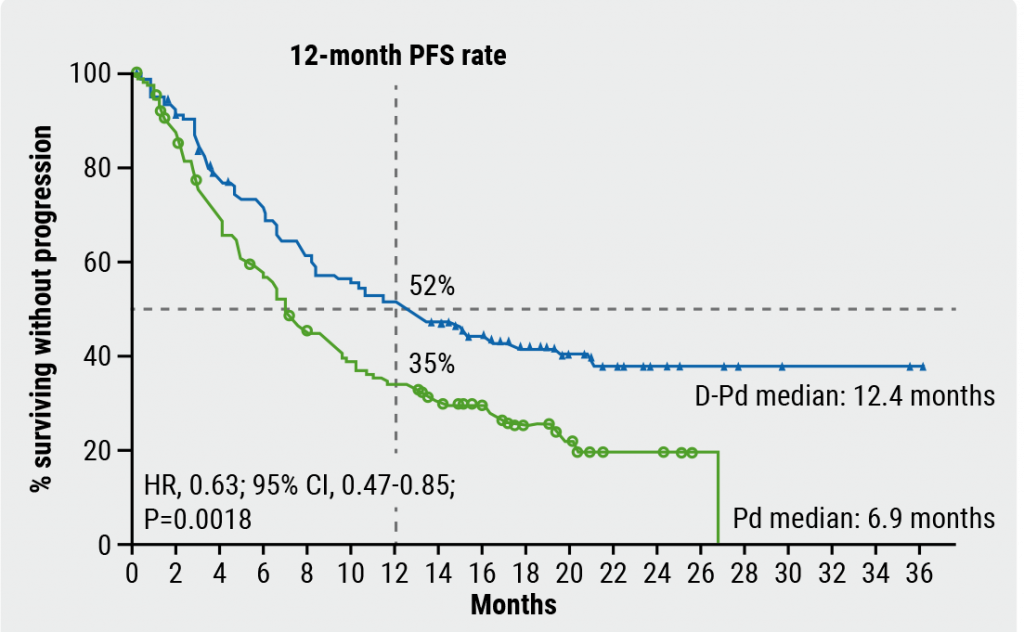MAIA (D-Rd vs Rd) and ALCYONE (D-VMP vs VMP) subgroup analyses showed improved PFS in both frail participants compared with non-frail participants with the daratumumab regimens [2,3]. When assessing safety outcomes, both these trials revealed a trend for increased death due to adverse events, total number of infections and tuberculosis rates in frail vs non-frail participants. However, the trials included few if any participants with an ECOG PS status ≥2 and with severe renal impairment [2,3], showing that data from these clinical trials might not be easy to extrapolate to clinical practice, according to Dr Bringhen [1].
So what can be done in the clinic? Upfront adjustment of dosing based on frailty classification is an option [4]. Steroid-sparing regimens have also emerged as an alternative in intermediate-fit and frail patients. The phase 3 RV-MM-PI-0752 trial showed no PFS difference between lenalidomide-dexamethasone followed by lenalidomide maintenance (RD-R) compared with continuous lenalidomide-dexamethasone dosing (RD) in intermediate fit participants [5]. Similarly, the phase 3 IFM2017-03 trial showed improved response rates with daratumumab-lenalidomide (DR) versus lenalidomide-dexamethasone (Rd) in frail participants without an increase in discontinuation rates, but with an increase in hematologic toxicities, providing an alternative to the steroid-sparing regimen [6].
But what can be expected from future trials? The UK-MRA FiTNEss (MYELOMA IX, NCT03720041) trial is assessing ixazomib-RD (IRD) fitness-adapted induction dosing regimens for fit, intermediate fit and frail participants with newly diagnosed transplant-ineligible multiple myeloma, followed by maintenance with either ixazomib plus lenalidomide or lenalidomide alone. Another ongoing trial is SWOG-S2209 (NCT05561387) which assesses bortezomib with Rd (VRd-lite), DR-dexamethasone (DRd) followed by lenalidomide maintenance or DRd followed by DR in intermediate fit or frail participants. Both these trials will serve to inform treatment decisions for intermediate fit or frail patients.
Dr Bringhen concluded by saying frailty indexes should be used in routine clinical practice to inform treatment decisions. In her opinion, doublet regimens are preferred over triplet regimens in frail patients, with the possibility of adding the third drug later on during treatment. “The ultimate goal should be to adjust the dose, schedule, and duration of therapy to achieve a situation whereby the patient can tolerate treatment and receive it for long enough” to derive benefit, said Dr Bringhen.
- Bringhen S, et al. Tailoring treatment in frail patients: current knowledge and future directions. Session IV: NDMM - transplant-ineligible patients. EMN 2024, 18–20 April. Turin, Italy. EMN 2024, 18–20 April. Turin, Italy.
- Facon T, et al. Leukemia. 2022;36(4):1066-1077.
- Mateos MV, et al. Clin Lymphoma Myeloma Leuk. 2021;21(11):785-798.
- Sim S, et al. Intern Med J. 2023;53(5):819-824.
- Larocca A, et al. Blood. 2023;137(22):3027-3036.
- Manier S, et al. Blood. 140(Supplement 1):1369–1370.
Medical writing support was provided by Mihai Surducan, PhD.
Copyright ©2024 Medicom Medical Publishers
Posted on
Previous Article
« Meet the Trialist: Dr Andrew Blauvelt on the KNOCKOUT Trial Next Article
Managing transplant-ineligible elderly and frail patients with multiple myeloma »
« Meet the Trialist: Dr Andrew Blauvelt on the KNOCKOUT Trial Next Article
Managing transplant-ineligible elderly and frail patients with multiple myeloma »
Related Articles

August 28, 2020
Carfilzomib: no PFS benefit for multiple myeloma
March 5, 2020
Off-the-shelf natural killer cells

February 18, 2021
Subcutaneous daratumumab plus pomalidomide and dexamethasone in R/R MM
© 2024 Medicom Medical Publishers. All rights reserved. Terms and Conditions | Privacy Policy
HEAD OFFICE
Laarderhoogtweg 25
1101 EB Amsterdam
The Netherlands
T: +31 85 4012 560
E: publishers@medicom-publishers.com

